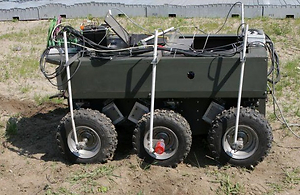Current issue
Online first
Archive
About the Journal
Aims and scope
Publisher and Editorial
Advertising policy
For Authors
Paper review procedures
Procedures protecting authentic authorship of papers
Paper preparation manual
Plagiarism check
Publication ethics
Reviewers
APC
Editorial and Scientific Board
Contact
Reviewers
Energy balance comparison of small unmanned vehicle equipped with electric and hybrid propulsion system
1
Faculty of Mechanical Engineering, Military University of Technology, Poland
Submission date: 2020-05-12
Final revision date: 2020-07-10
Acceptance date: 2020-07-11
Publication date: 2020-09-30
Corresponding author
Filip Polak
Faculty of Mechanical Engineering, Military University of Technology, Gen. S. Kaliski, Warsaw, Poland
Faculty of Mechanical Engineering, Military University of Technology, Gen. S. Kaliski, Warsaw, Poland
Combustion Engines 2020,182(3), 23-27
KEYWORDS
TOPICS
ABSTRACT
Article presents comparison of the energetic balance of vehicle powertrain – pure electric vehicle and vehicle equipped with electric hybrid power transmission. Society is more and more often persuaded to buy electric cars as an environmentally friendly solution because they have opinion of ecological vehicles. Electrification in military applications is also widely considered, especially in case of small to medium UGV’s such as wide range of robotic systems introduced to the milatary operations. The article presents the problems of comparing the efficiency and others parameters such as the range of a two presented powertrains. The research was carried out on an small unmanned land platform equipped with a hybrid propulsion system supplied as standard with Diesel power generator and electrically only powered. Energy used for charging of the battery, from tank-to-wheel, was calculated. This also enables to calculate total efficiency of electric and hybrid power transmission. By calculating different capacity of battery and power of generator, it is possible to determine the vehicle range.
REFERENCES (16)
1.
FLUDER, K., PIELECHA, I., CIEŚLIK, W. The impact of drive mode of a hybrid drive system on the energy flow indicators in the RDE test. Combustion Engines. 2018, 175(4),18-25. https://doi.org/10.19206/CE-20....
2.
KARCZEWSKI, M., SZCZĘCH, L. Influence of the F-34 unified battlefield fuel with bio components on usable parameters of the IC engine. Eksploatacja i Niezawodność – Maintenance and Reliability. 2016, 8(3), 358-366. https://doi.org/10.17531/ein.2...
3.
KARCZEWSKI, M., SZCZĘCH, L., POLAK, F. Energetic balance of unmanned ground vehicle hybrid power transmission. Journal of KONES Powertrain and Transport. 2018, 25(2). https://doi.org/10.2478/kones-....
4.
KARCZEWSKI, M., SZCZĘCH, L., POLAK, F. Energetic balance of unmanned ground vehicle. Journal of KONES Powertrain and Transport. 2019, 25(2). https://doi.org/10.5604/01.300....
5.
LOPEZ, R., DARPA Develops tactical robots for dirty and dangerous missions. unmanned systems. 2001, 12-13.
6.
PIELECHA, I., CIEŚLIK, W., FLUDER, K. Analysis of energy management strategies for hybrid electric vehicles in urban driving conditions. Combustion Engines. 2018, 173(2), 14-18. https://doi.org/10.19206/CE-20....
7.
POLAK, F., WALENTYNOWICZ, J. Problemy doboru zespołów układu napędowego do małego taktycznego pojazdu bezzałogowego. Journal of KONES Powertrain and Transport. 2007, 14(4), 343-350.
8.
POLAK, F., SZCZĘCH, L. Driving module of the unmanned vehicle. Journal of KONES Powertrain and Transport. 2011, 18(1).
9.
POLAK, F., SZCZĘCH, L., WALENTYNOWICZ, J. Napęd lekkiej platformy bezzałogowej do działań w terenie zurbanizowanym. Technologie podwójnego zastosowania, Wybrane Technologie Wojskowej Akademii Technicznej (red.). Najgebauera, A. WAT, Warszawa 2012.
10.
POLAK, F., SZCZĘCH, L. Propulsion module for unmanned vehicle. Journal of KONES Powertrain and Transport. 2011, 18(1).
11.
REDELBACH, M., ÖZDEMIR, E.D. Optimizing battery sizes of plug-in hybrid and extended range electric vehicles for different user types. Energy Policy. 2014, 73, 158-168. https://doi.org/10.1016/j.enpo....
12.
RYBAK, P., WYSOCKI, J., HRYCIÓW, Z. et al. Experimental research on identifying data for modelling special purpose vehicles. Journal of KONES Powertrain and Transport. 2017, 24(3). https://doi.org/10.5604/01.300....
13.
SANDY, T.C.E. Sustainable transportation options for the 21st century and beyond. Appendix A: Range limitations of battery electric vehicles. Springer International Publishing. Switzerland 2015. https://doi.org/10.1007/978-3-....
CITATIONS (1):
1.
Energy management system of the hybrid ultracapacitor-battery electric drive vehicles
Ireneusz Pielecha
Archives of Transport
Ireneusz Pielecha
Archives of Transport
Share
RELATED ARTICLE
We process personal data collected when visiting the website. The function of obtaining information about users and their behavior is carried out by voluntarily entered information in forms and saving cookies in end devices. Data, including cookies, are used to provide services, improve the user experience and to analyze the traffic in accordance with the Privacy policy. Data are also collected and processed by Google Analytics tool (more).
You can change cookies settings in your browser. Restricted use of cookies in the browser configuration may affect some functionalities of the website.
You can change cookies settings in your browser. Restricted use of cookies in the browser configuration may affect some functionalities of the website.



